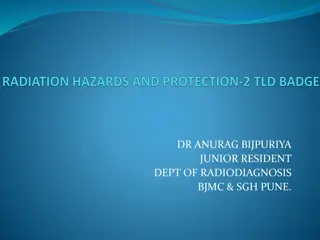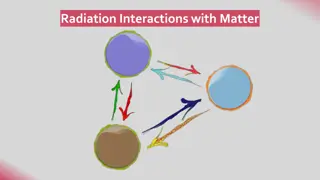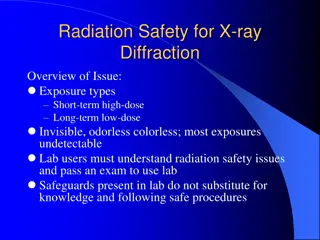Understanding Biological Effects of Radiation in Radiation Biology Lecture
This lecture by Dr. Zaid Shaker Naji delves into the biological effects of radiation, including deterministic and stochastic effects. It covers mechanisms of damage at the cellular level, such as direct and indirect damage, and discusses somatic and genetic damages that can arise following exposure. The lecture also explores the determinants of radiation effects, including radiation dose and dose rate, as well as species sensitivity to radiation.
Download Presentation

Please find below an Image/Link to download the presentation.
The content on the website is provided AS IS for your information and personal use only. It may not be sold, licensed, or shared on other websites without obtaining consent from the author. Download presentation by click this link. If you encounter any issues during the download, it is possible that the publisher has removed the file from their server.
E N D
Presentation Transcript
RADIATION BIOLOGY Lecture (6) By Dr. Zaid Shaker Naji
Biological Effects ofRadiation 1.Deterministic effect The probability of these effects is not proportional to the absorbed dose This effect has a threshold, below which the effect will not occur. Severity of this effect is directly proportional to absorbeddose This effect of radiation can cause cataract, hair loss, infertility.
2. Stochasticeffect Probability of this effect is directly proportional to absorbeddose. There is no threshold, so any dose may or may not produce thiseffect Severity of this effect is independent on the absorbeddose. Stochastic effect of radiation can cause cancers or genetic modifications.
Mechanisms ofDamage 1.Direct mechanism: Radiation directly hit atoms of macromolecules (DNA, RNA, proteins, lipids & carbohydrates) 2.Indirect mechanism: Radiation hit water to form free radicals in a process called radiolysis which can contribute to the destruction of thecell.
Cellular damage ofradiation Transfer radiation energy to atoms and molecules in the cellular structure (DNA) lead to genomic instability dueto: 1. Single-strand break 2. Double-strand break 3. Hydrogen bond breakage 4. DNA cross-linkage 5. Pyrimidine Dimer 6. Base change 7. Base loss
within seconds (physical& biochemical effects) within few minutes (Cell death or Cellrepair) Within hours-days-weeks or months (clinical symptoms): a)Somatic damages arise from genomic instability in somatic cells of irradiated person either appear early after exposure (hair loss, infertility), or appear late after exposure (cataract & cancer) b)Genetic damages arise from genomic instability in germ cells of irradiated parents and seen in their offspring as genetic malformations.
Determinants of RadiationEffects 1.Type of radiation 2.The radiation dose dose required for killing 50% of the individuals in a 30 day period 3.The dose rate ofradiation 4.Species Sensitivity(LD50/30) Lethal doses for plants and microorganisms are larger than those for mammals
Determinants of Radiation Effects 5. Cell Sensitivity (Bergonie & Tribondeau Law)Radio-sensitivity of a tissue is directlyproportional to the rate of reproduction of its cells, and inversely proportional to the degree of celldifferentiation.
Determinants of RadiationEffects 6.Part of the body exposed (hands or feet) are able to receive a greater amount of radiation withless resulting damage than blood forming tissues found in the bone marrow. 7.Age of individual As a person ages, cell division slows and body is less sensitive to effects of radiation. 8.Area exposed The larger the area exposed, the greater the overall damage. Therefore, radiation therapy doses should be delivered to very limited areas (to tumor sites) rather than whole-body irradiation of the same dose.























